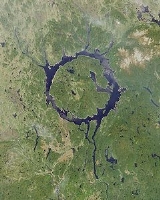
Manicouagan Reservoir
Overview
Annulus (mathematics)
In mathematics, an annulus is a ring-shaped geometric figure, or more generally, a term used to name a ring-shaped object. Or, it is the area between two concentric circles...
lake in central Quebec
Quebec
Quebec or is a province in east-central Canada. It is the only Canadian province with a predominantly French-speaking population and the only one whose sole official language is French at the provincial level....
, Canada
Canada
Canada is a North American country consisting of ten provinces and three territories. Located in the northern part of the continent, it extends from the Atlantic Ocean in the east to the Pacific Ocean in the west, and northward into the Arctic Ocean...
. The lake covers an area of 1,942 km²
1 E9 m²
To help compare orders of magnitude of different geographical regions, we list here areas between 1,000 km2 and 10,000 km2. See also areas of other orders of magnitude.* areas less than 1000 km2* 1,000 km2 is equal to:...
, and its eastern shore is accessible via Route 389
Quebec route 389
Quebec's Route 389 connects Route 138 adjacent to Baie-Comeau with the Newfoundland and Labrador border, connecting with the Trans-Labrador Highway to Wabush and Labrador City, and beyond to Goose Bay...
. The island in the centre of the lake is known as René-Levasseur Island
René-Levasseur Island
René-Levasseur Island is a large island in the center of Lake Manicouagan in Quebec, Canada. Its highest peak is Mount Babel, at 952 m . With a total area of 2,020 km² , the island is larger in terms of area than the lake in which it is situated...
, and its highest point is Mount Babel
Mount Babel (Quebec)
Mount Babel is the highest peak of the René-Levasseur Island, at above sea-level, which is above the Manicouagan Reservoir level. It lies within the Louis-Babel Ecological Reserve in Quebec, Canada.-History:...
. The lake and island are clearly seen from space and are sometimes called the "eye of Quebec." With a volume of 139.8 cubic kilometres (33.5 cu mi), the reservoir itself is the fifth largest in the world by volume, although only 35.2 cubic kilometres (8.4 cu mi) can be used for hydro-electric power production.
Unanswered Questions
Discussions

